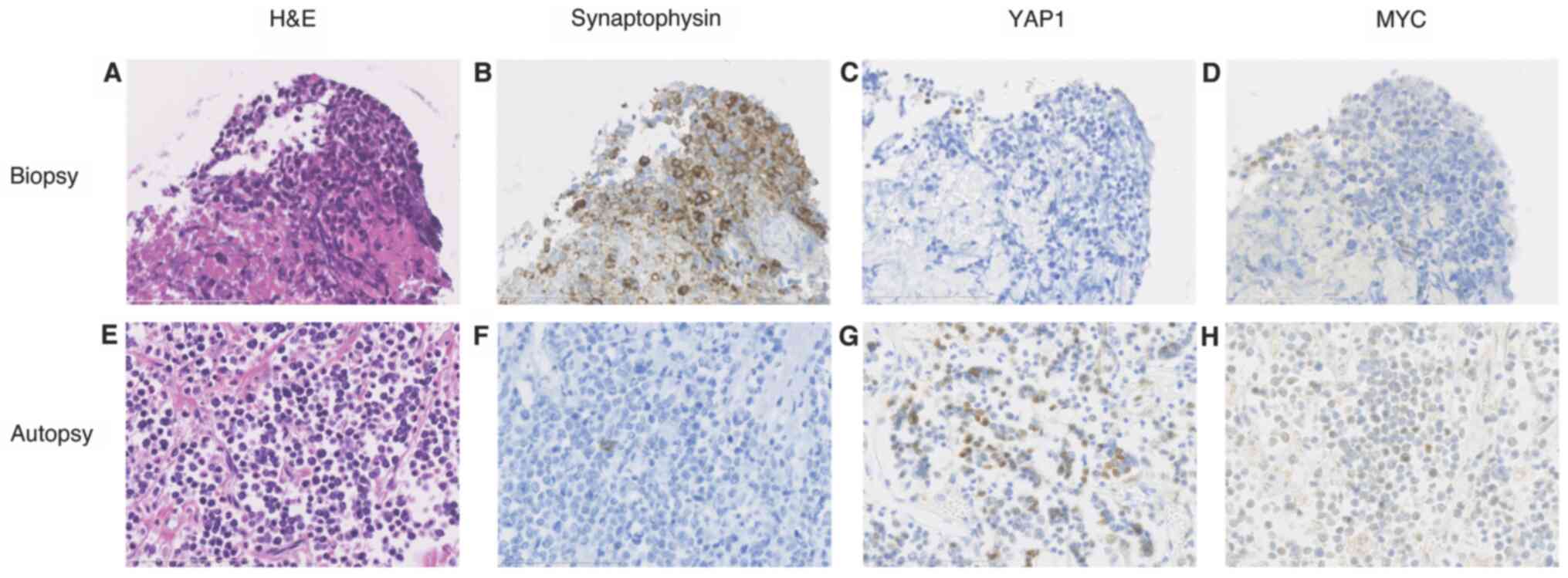|
1
|
Jackman DM and Johnson BE: Small-cell lung
cancer. Lancet. 366:1385–1396. 2005.PubMed/NCBI View Article : Google Scholar
|
|
2
|
Rudin CM, Poirier JT, Byers LA, Dive C,
Dowlati A, George J, Heymach JV, Johnson JE, Lehman JM, MacPherson
D, et al: Molecular subtypes of small cell lung cancer: A synthesis
of human and mouse model data. Nat Rev Cancer. 19:289–297.
2019.PubMed/NCBI View Article : Google Scholar : Erratum in: Nat Rev
Cancer 19: 415, 2019.
|
|
3
|
McColl K, Wildey G, Sakre N, Lipka MB,
Behtaj M, Kresak A, Chen Y, Yang M, Velcheti V, Fu P, et al:
Reciprocal expression of INSM1 and YAP1 defines subgroups in small
cell lung cancer. Oncotarget. 8:73745–73756. 2017.PubMed/NCBI View Article : Google Scholar
|
|
4
|
Borromeo MD, Savage TK, Kollipara RK, He
M, Augustyn A, Osborne JK, Girard L, Minna JD, Gazdar AF, Cobb MH,
et al: ASCL1 and NEUROD1 reveal heterogeneity in pulmonary
neuroendocrine tumors and regulate distinct genetic programs. Cell
Rep. 16:1259–1272. 2016.PubMed/NCBI View Article : Google Scholar
|
|
5
|
Huang YH, Klingbeil O, He XY, Wu XS, Arun
G, Lu B, Somerville TDD, Milazzo JP, Wilkinson JE, Demerdash OE, et
al: POU2F3 is a master regulator of a tuft cell-like variant of
small cell lung cancer. Genes Dev. 32:915–928. 2018.PubMed/NCBI View Article : Google Scholar
|
|
6
|
Poirier JT, George J, Owonikoko TK, Berns
A, Brambilla E, Byers LA, Carbone D, Chen HJ, Christensen CL, Dive
C, et al: New approaches to SCLC therapy: From the Laboratory to
the Clinic. J Thorac Oncol. 15:520–540. 2020.PubMed/NCBI View Article : Google Scholar
|
|
7
|
Horie M, Saito A, Ohshima M, Suzuki HI and
Nagase T: YAP and TAZ modulate cell phenotype in a subset of small
cell lung cancer. Cancer Sci. 107:1755–1766. 2016.PubMed/NCBI View Article : Google Scholar
|
|
8
|
Goldstraw P, Chansky K, Crowley J,
Rami-Porta R, Asamura H, Eberhardt WE, Nicholson AG, Groome P,
Mitchell A, Bolejack V, et al: International Association for the
Study of Lung Cancer Staging and Prognostic Factors Committee,
Advisory Boards, and Participating Institutions: The IASLC lung
cancer staging project: Proposals for revision of the TNM stage
groupings in the forthcoming (eighth) edition of the TNM
classification for lung cancer. J Thorac Oncol. 11:39–51.
2016.PubMed/NCBI View Article : Google Scholar
|
|
9
|
Pearsall SM, Humphrey S, Revill M, Morgan
D, Frese KK, Galvin M, Kerr A, Carter M, Priest L, Blackhall F, et
al: The rare YAP1 subtype of SCLC revisited in a biobank of 39
circulating tumor cell patient derived explant models: A brief
report. J Thorac Oncol. 15:1836–1843. 2020.PubMed/NCBI View Article : Google Scholar
|
|
10
|
Baine MK, Hsieh MS, Lai WV, Egger JV,
Jungbluth AA, Daneshbod Y, Beras A, Spencer R, Lopardo J, Bodd F,
et al: SCLC Subtypes Defined by ASCL1, NEUROD1, POU2F3, and YAP1: A
comprehensive immunohistochemical and histopathologic
characterization. J Thorac Oncol. 15:1823–1835. 2020.PubMed/NCBI View Article : Google Scholar
|
|
11
|
Ireland AS, Micinski AM, Kastner DW, Guo
B, Wait SJ, Spainhower KB, Conley CC, Chen OS, Guthrie MR, Soltero
D, et al: MYC drives temporal evolution of small cell lung cancer
subtypes by reprogramming neuroendocrine Fate. Cancer Cell.
38:60–78.e12. 2020.PubMed/NCBI View Article : Google Scholar
|
|
12
|
Patel AS, Yoo S, Kong R, Sato T, Sinha A,
Karam S, Bao L, Fridrikh M, Emoto K, Nudelman G, et al:
Prototypical oncogene family Myc defines unappreciated distinct
lineage states of small cell lung cancer. Sci Adv.
7(eabc2578)2021.PubMed/NCBI View Article : Google Scholar
|
|
13
|
Walker TL, White JD, Esdale WJ, Burton MA
and DeCruz EE: Tumour cells surviving in vivo cisplatin
chemotherapy display elevated c-myc expression. Br J Cancer.
73:610–614. 1996.PubMed/NCBI View Article : Google Scholar
|
|
14
|
Ikematsu Y, Tanaka K, Toyokawa G, Ijichi
K, Ando N, Yoneshima Y, Iwama E, Inoue H, Tagawa T, Nakanishi Y, et
al: NEUROD1 is highly expressed in extensive-disease small cell
lung cancer and promotes tumor cell migration. Lung Cancer.
146:97–104. 2020.PubMed/NCBI View Article : Google Scholar
|
|
15
|
Sugiyama K, Kogure Y, Torii A, Shiraishi
K, Yamada A, Ishida A, Shigematsu F, Nozawa K, Niwa H, Oka S, et
al: Solvent-based paclitaxel or nab-paclitaxel for heavily treated
relapsed/refractory small cell lung cancer: Retrospective
single-institution observational study. Medicine (Baltimore).
98(e14758)2019.PubMed/NCBI View Article : Google Scholar
|
|
16
|
Naito Y, Tamiya A, Tamiya M, Kimura Y,
Hamaguchi M, Saijo N, Kanazu M, Tokura S, Shiroyama T, Morisita N,
et al: Efficacy of nanoparticle albumin-bound paclitaxel regimens
for relapsed small cell lung cancer: A retrospective analysis.
Medicine (Baltimore). 96(e7884)2017.PubMed/NCBI View Article : Google Scholar
|
|
17
|
Gelsomino F, Tiseo M, Barbieri F, Riccardi
F, Cavanna L, Frassoldati A, Delmonte A, Longo L, Dazzi C, Cinieri
S, et al: Phase 2 study of NAB-paclitaxel in SensiTivE and
refractory relapsed small cell lung cancer (SCLC) (NABSTER TRIAL).
Br J Cancer. 123:26–32. 2020.PubMed/NCBI View Article : Google Scholar : Erratum in: Br J
Cancer 125: 306, 2021.
|
















